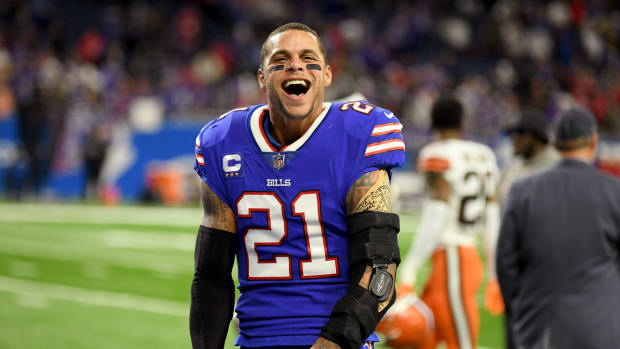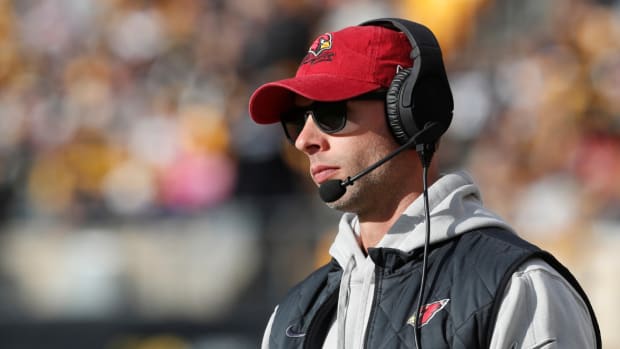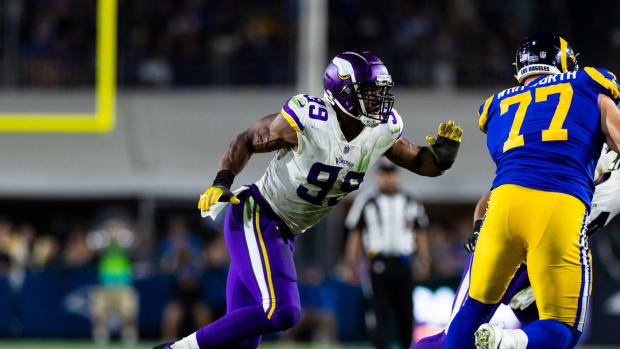Five Giants, and Those Forgotten After the Storm
JUNCOS, Puerto Rico — Rain brings anxiety to the island of Puerto Rico, even now, eight months after the storm. Some schools let out early to assuage parents’ fears that their children won’t be able to make it home. The blue tarps covering homes across the island, taking the place of roofs destroyed by Hurricane Maria, don’t keep all the water out.
But Saturday’s late-morning shower is a light one. Soon enough, the sun is again baking a grass field and thirty-some kids, aged 9 to 17, are eager to play football. Today, they have some company.
Juncos, about 25 miles southeast of San Juan, was hit particularly hard by Maria, as the storm cut across the island on a northwest trajectory, its 155 mph winds striking the eastern edge of the island and mowing through the interior. Much of this community is, remarkably, still without power, less than two weeks away from the next hurricane season. There is a little stadium here, with a track and a small grandstand surrounding the field, but the light posts are useless. What little equipment the community football club had was lost, like so much else, in the storm.
When football practices started up again after Maria, only eight players showed up—they’d had approximately 40 just a few weeks before. Many families were displaced or relocated from the area, as there was no school, no light, no water. The team’s director, Jacqueline Santiago, sent her two sons, aged 14 and 15, to live with her brother in Philadelphia while she and her husband, a paramedic, stayed back to help with the recovery.
“This has helped me,” Santiago says, gesturing toward the field. “This has helped the kids—having a place to take their mind off their situation, giving them a sense of value.”
Here in the island’s interior states, removed from the beach resorts of the San Juan metro area, citizens often feel overlooked. But today, two large white vans pull up to the edge of the field. A group of players, from an NFL franchise some 1,600 miles away, is about to join their team.
Maria made landfall in Puerto Rico on Sept. 20, two days after the Giants lost a Week 2 Monday Night Football game to Detroit. The football calendar is context for how long the thousands of Puerto Ricans still without power have been leading disrupted lives. In the time since, the New York Giants finished the season 3-13, fired and hired a coach, fired and hired a general manager, mended locker-room rifts, drafted an exciting young running back and began practicing for the next football season.
The 2017 hurricane season was one of the worst on record. Within a month, Harvey struck Texas; Irma, Florida; and Maria, the Caribbean. The Giants have been supporting Americares, a Connecticut-based non-profit that works to provide medicine and access to health care in areas affected by poverty or disaster, as far back as their 9/11 emergency response. They committed $400,000 to Americares last fall—part of a $1 million donation for hurricane relief—which aided their response to all three storms. Eight months later, five Giants players arrived in Puerto Rico to see Americares’ ongoing efforts firsthand.
Safety Landon Collins needed a second surgery on his broken forearm a few weeks before the trip, but as a Hurricane Katrina survivor, that didn’t stop him from coming. He’d simply wear an arm brace. New left tackle Nate Solder, who hopes he can make an impact both on and off the field with his $62 million contract, committed to the trip soon after he signed with the Giants. (Solder has a cousin in Puerto Rico, a freelance boat captain who’s only had 20 days of work in the past six months as tourism sagged.) So did free-agent signees Michael Thomas and Teddy Williams, both Texas natives who have contributed to Harvey relief in Houston. And cornerback Eli Apple, coming off a tumultuous season in which he clashed with teammates and coaches and was suspended for the final game, is trying to move forward in a positive direction. One of his goals, he said, is to do more community outreach. He’s been a Play 60 ambassador for a middle school in New Jersey this spring; Puerto Rico was another opportunity.
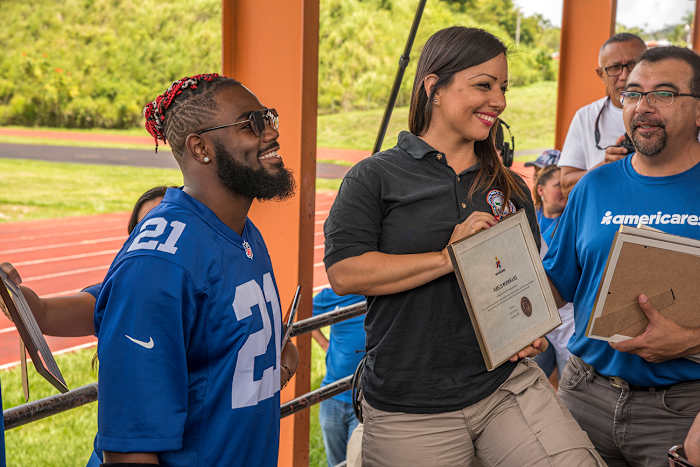
For Collins, Puerto Rico was reminiscent to his New Orleans home after Hurricane Katrina.
Jake Rauscher/Americares
Last Thursday, they loaded a sprinter van bound for JFK airport after a morning workout. Fridays are off days in the team’s offseason program, so this trip fit in right before the start of organized team activities. Three of the five players are new to the team, but you’d never be able to tell—the younger DBs are already calling Thomas “Uncle Mike.” A disaster relief team like Americares is probably something like a locker room, Thomas will say later; the new faces are assimilated easily.
The Americares group meets the Giants contingent at the San Juan airport around midnight, then shuttles them 90 minutes to Ponce, a city on Puerto Rico’s south coast that would be their home base for the next two nights. The next day at 8 a.m., the players sit at a breakfast table over eggs and a sweet Puerto Rican oatmeal blend, receiving a primer on what they’d see over the next 36 hours.
“It’s no surprise that the storm was unprecedented,” Kate Dischino, Americares’ vice president of emergency programs, tells them. “The amount of damage—you had power, infrastructure, water, communications, everything was out. … Today, you have roughly 98% of the power that’s restored. That means, still, about 30,000 people on the island, many of whom you’ll meet today, in some of the communities we are going to, don’t have power. It is eight months. It is unbelievable. It is something the U.S. has never seen.”
• 30 YEARS LATER, A COACH GETS HIS DEGREE: The story of Anthony Lynn’s quiet return to college.
Visiting the parts of Puerto Rico most affected by Maria requires hours spent in a car, winding up narrow mountain roads on which a single truck making a delivery can cause a traffic jam, weaving around a bend where the former edge of the road is simply marked by a pole. It’s on one of these rides when Collins, sitting in the back of a white Americares van, spots those all-too-familiar blue tarps.
“I can remember our house was the same way,” Collins says. “It’s crazy to see that. I can picture what they are going through and how they are feeling about it. I know that feeling.”
Collins was just starting sixth grade when Hurricane Katrina engulfed his hometown of New Orleans. The roof on his mom’s house was damaged, requiring a blue tarp; his father’s house in Port Sulphur, on the bank of the Mississippi River, was ripped off the ground, half of it deposited on a nearby football field. “The worst part was not being able to come home,” he says. He’d evacuated with his mom and siblings a few hours north, where they spent months living with extended family. But soon there was a diaspora. Relatives scattered to Texas and California. Collins attended multiple middle schools, before attending Dutchtown High School, west toward Baton Rouge, where his dad and stepmom had re-settled.
“Everything was a total disaster, and it was like, what can we do to make it better for ourselves?” says Collins. “We had tough times, trying to figure stuff out at a young age. You are just trying to be a kid, but at the same time, you realize, it’s not the same.”
San Inocencio A. Montero School, an elementary/intermediate school up in the mountains in Utuado, is filled with 300 students experiencing those same feelings. The school is less than 30 miles from Ponce, but the drive takes an hour-and-a-half, an indicator of how isolated some parts of the island are. Multiple bridges in this municipality were washed out; in place of one bridge, community members rigged up a cable and a shopping cart to send food and water across the river. Another, on a small highway that leads to the school, has just reopened this morning.
Americares ran a mobile medical clinic out of this school soon after Maria hit; today, the Giants are helping them lead the students in a mental health exercise, an important part of long-term relief (suicide rates in Puerto Rico rose 29% in 2017 over the previous year, with a significant spike after the storm). Each student holds a piece of paper labeled El heroe que vive en nostros, “the hero who lives in us.” One kid selects Captain America. Two others write madre, their mother. They place their papers on a rainbow tarp and shake them, a celebration of heroes at home and in their community.
This school did not re-open after Maria until December. Just two months ago, they resumed full school days, 8 a.m. to 3 p.m., but an agricultural education teacher says they let out at noon if the rain comes in hard. The basketball court where the Giants spend an hour playing with the kids, jumping rope and hula-hooping (and, yes, losing a massive tug of war), is being used for the first time since the storm. The school received a special permit to re-open it, on account of the Giants’ visit.
Collins hopes to launch his own disaster relief foundation this year, focusing on re-building homes that have been destroyed. Where his dad’s house once stood in Port Sulphur, Collins says, was never rebuilt; trailers occupied the site, even years later. Driving through the central mountains, house remnants are a common sight. One spray-painted sign, along a narrow highway overlooking the man-made Lake Caonillas reads, Estamos en la promixa casa, “We are in the next house.” Where this house once stood is now a pile of rubble.
Sitting around a folding table, eating a lunch of rice, beans and chicken, Collins and Thomas are talking about Rosa Rivera.
They met her earlier this morning, at a federally qualified health center in Utuado that serves low-income and uninsured patients. The Giants players delivered an Americares shipment containing $90,000 in medicine that can then be given to patients for free, to treat chronic conditions like diabetes and hypertension or upper respiratory infections common after hurricanes. Americares provided $40 million in aid to areas hit by Maria, including some 240,000 prescriptions filled, to help partners like this clinic treat storm survivors.
Rivera, a patient of the clinic before and after the storm, was treated here for leukemia and is also a diabetic. When Maria hit, the Paso Palmas neighborhood of Utuado, where she lives, was difficult to access because of its sharp terrain. Clinic workers set out in trucks, on foot and on horseback, delivering critical supplies like the pain medicine and insulin Rivera needs. She says she got water back three weeks ago but lost it again last week. Rivera does not expect her power to be restored until January, 16 months after Maria.
“January,” Thomas says. “It’s May now. I just couldn’t believe that.”
Puerto Rico’s utilities grid was fragile before Maria, and the process of restoring it after the largest blackout in American history has been as tenuous as some of the power lines snaking through the mountains. In April, an excavator hit a transmission tower in the south, and the lights went out again across the island. The clinic taught Rivera how to bury her insulin underground in cool places, where it can keep for up to 28 days.
“I hope they know there are people outside that care about them,” Solder says. “In a lot of ways, I think I would feel forgotten. It’s hard to send that message unless you are here, speaking to people, showing that you care.”
In isolated parts of the island’s interior, these clinics feel like an oasis. In March, a free community clinic opened up in the rural region of Mameyes, serving seven nearby villages. Before it opened, the nearest clinic was the previous one the Giants visited—a trek that takes them more than an hour, even with ready transport and good road conditions. Francisco Valentin, a community organizer known as Tito, runs the gas station up the road and for the past two months has kept the clinic’s doors open, without help from the government.
“We have a lot of problems right now in Puerto Rico,” Valentin says. “We received a big hurricane. We may receive another hurricane in the next year. This is our reality as a people. But we are trying to deliver hope to the communities, and be responsible for a real change. This is an example of, if you want, you can.”
On his way into the clinic, Valentin proudly points to a bulldozer parked outside, which he says was used to clear the community’s roads from the post-Maria debris. The facility is powered entirely by solar panels, a donation Valentin solicited from a German company—more reliable than the FEMA generators at the water facility, which he says sometimes go out, leaving the community without consistent running water. The clinic serves about 30 patients a day, and on this Friday afternoon in May, the waiting room is full. They rely entirely on volunteers, and Americares has assisted with some of the staffing as the clinic works to gain traction, today providing both a doctor and a nurse. They have also brought a group of more than 20 people, including the five Giants players, ready and willing to paint a hallway in the back of the warehouse-turned-clinic, near where Valentin hopes to install dental chairs.
Solder is the last one working. His 6' 8" “grande” frame is perfect for painting the bare ceiling, and he keeps going until he’s covered every inch.
On Saturday morning, the Giants are standing in the building that once housed the COSSMA health clinic, in the town of San Lorenzo. Maria’s high winds blew off the roof and water came dumping in, rendering the structure a total loss. What’s left are piles of fiberglass, mangled beams and loose wires. It smells of mold.
“This is eight months later,” says Raul Pineda, Americares’ recovery director for Latin America. “It’s amazing what water can do.”
When the clinic’s executive director, Isolina Miranda, returned to assess the damage in September, her employees began crying. They worried they would no longer have jobs. But in the first days after the storm, the clinic continued serving patients out in the parking lot, under the hot sun. Americares soon delivered a climate-controlled medical tent, which is still being used as a patient triage area; exam rooms were later set up in semi-permanent trailers as the clinic raises money for a new building. Standing inside the destroyed structure as water drips down from a morning rain shower, Apple reaches over to give Miranda a hug. “Thank you,” she says.
“You are never going through anything as bad as you think you are when you come out and see how some people are living,” Apple says. “It’s humbling.”
Apple had a few reasons for wanting to come on this trip. He wanted to show support to a U.S. territory that is still struggling. He also wanted to strengthen his relationships with his teammates. “You can trust each other more,” he says, “when you build a relationship off the field.” That includes Collins, his secondary-mate, with whom he openly feuded last year. Apple was disciplined by the team multiple times during the 2017 season, and Collins later referred to him as a “cancer” in a radio interview.
“We have spent some time together and had some great conversations,” Apple says. “The secondary is a lot of communication, so you can’t just not talk to each other. Obviously, there was going to be a time when we had to meet up face-to-face and talk, and we have been doing a great job of that. Football is a super competitive sport, so sometimes the high intensity can get to you a little bit, can weigh on you. But at the end of the day, that’s family. We buried the hatchet and got it moving during the offseason.”
The two met after the season in New Jersey to clear the air, Apple said; they even went out together a few times. New Giants coach Pat Shurmur has talked often about giving everyone on the team a “clean slate.” Apple has been contrite about his rocky 2017 season, telling reporters at the start of OTAs that he was embarrassed about how it ended. The fact that both he and Collins were on the same trip to Puerto Rico is as good an indicator as any that they are committed to moving forward. While eating lunch one day, Pineda asked which player in the group was the fastest. Collins pointed to Apple. Apple quickly pointed to Williams, who didn’t play college football but caught the attention of the NFL with his feats as a collegiate sprinter, once running the 100-yard dash in 9.9 seconds.
“When I found out he was coming on this trip, I said, ‘Cool, I got my guy,’” Collins says.
“I should never have said what I said about him. I’m understanding him more, he’s understanding me more, and we are getting on the same page. I love seeing him smile. He’s a character, and it makes me happy to see him happy, to see a smile on his face, that he’s not worried. If he can look at me as a big brother, and let me help him as much as I can, and I know big brothers can learn from little brothers, too.”
Two weeks earlier, that happened with another teammate. Williams and his family make their permanent home in Houston, and their own house was significantly damaged by Harvey. Wanting to help others in the area who had it worse than they did, Williams adopted a local youth football club, the Cypress Mustangs. He aimed to raise enough funds this spring to outfit 450 kids, ages 5 to 14, with uniforms, knowing many families affected by the storm might not have extra money to spend. But he was coming up short. Why not bring it up in front of the entire team, Apple suggested?
Shurmur called a team meeting, on a day when they weren’t otherwise going to have one, and Williams got up and told the whole story. Within five days, his teammates, the organization, ownership, even the NFL had pitched in. They raised $42,000, the full cost of the uniforms.
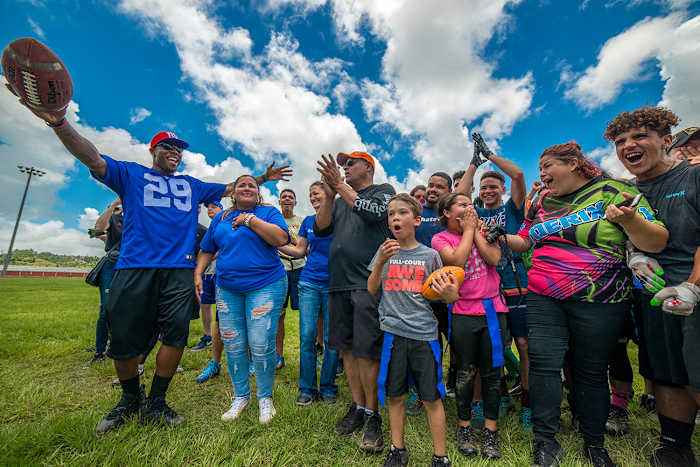
Teddy Williams, Jacqueline Santiago and the Juncos American Football Giants.
Jake Rauscher/Americares
When the vans pull up to the stadium in Juncos, a small crowd in the grandstand begins cheering. There are players, coaches, parents and a group of first responders from the nearby municipality of Humacao, who worked in Juncos during the storm, braving chest-high waters and living at the department for weeks.
One by one, they share their experiences. A 16-year-old girl who plays right tackle says that having football practice to attend after Maria helped take her mind off the havoc wreaked by the storm. A younger boy, who plays defensive end, says he lost a lot of things in the hurricane, but he also learned to value more things. Their families are among the estimated 3,000 people in Juncos still without power, but, everywhere you go in Puerto Rico, they want you to know, we are recovering! This community football league is one way they are doing so; one way they are trying to re-establish a normal routine.
Soon enough, the kids are running around the field, scrimmaging alongside five NFL players. They are allowed to blitz, after a three-second delay, and Solder counts in Spanish: uno Mississippi, dos Mississippi, tres Mississippi! Thomas is explaining to a kid lined up at safety that his job is to make everybody else on the defense right. Apple is demonstrating with his hands the proper way to play press coverage. Collins, throwing left-handed, launches what will be the winning score. It’s also the only score.
One of the team moms made gifts for each of the Giants players, handmade statues painted with the Puerto Rican flag. The Giants came with a gift as well, which they present at the end of the scrimmage: A $10,000 credit with Riddell to replace their team’s equipment. Eight months after the storm, in a community still recovering, this is a validation that they have not been forgotten. Santiago begins to cry, then the head coach makes an announcement. The new mascot of the Juncos American Football Club will be the Giants.
• Question or comment? Email us at talkback@themmqb.com.





































